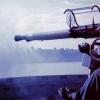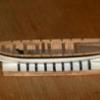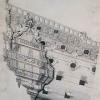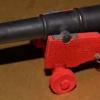Supplies of the Ship Modeler's Handbook are running out. Get your copy NOW before they are gone! Click on photo to order.
×
-
Posts
1,171 -
Joined
-
Last visited
Reputation Activity
-
 jud got a reaction from thibaultron in Cannon Maintenance
jud got a reaction from thibaultron in Cannon Maintenance
Cannon Maintenance. 3"50, Mount 34, USS Helena CA 75, 1961.
-
 jud got a reaction from thibaultron in Cannon Maintenance
jud got a reaction from thibaultron in Cannon Maintenance
When fast torpedo boats and aircraft came into their own, going to Action Stations or General Quarters in a war Zone for Sunrise and Sunset became the norm, because attacking from out of the sun just coming over the horizon or dipping into it was advantageous, with the Radars and Gun Control Systems of today, not so much. Although ready service ammunition was at the gun or very close to it, it was not normal to load it, in the days of sail there was plenty of time for that and as Breach Loaders became the norm, it did not take long to load the guns. Muzzle loaders had, as part of their equipment a large screw device with a pointed end to the screw all mounted to a ramrod. It was used to work the projectial loose so it could be withdrawn or rolled out on it own and the powder bag also was hooked and withdrawn with that tool. Fixed ammo for a breach loader all is contained and held together by the cartridge case that is manufactured with a way to control head space and to extract the cartridge with or without it being fired. With rifled guns the lands and groves do not start abruptly, there is a forcing cone built into the barrel that allows for transition for the rotating band or brass bullet jacket to fit itself. On Semi Fixed or Bag type guns, all that is there but the rammer does not ram the projectial far enough into the forcing cone that it can't be backed out with a ramrod through the muzzle if it does not follow the cartridge out with a raised muzzle for Semi Fixed Ammo, Bag Guns require the ramrod after the powder bags have been withdrawn. and are a pain in the butt unloading in any manner but through the muzzle, in other words, shooting the dam thing. Never had to unload a Bag gun, we did not load them unless we intended to shoot and the loading was done on command, not an automatic part of manning the guns. Have unloaded many times misfires from 3"50s and a few 40MM Bofers, but always attempted to get them to fire by rigging a firing circuit or in the case of the 40 MM Bofers re-cocking the firing pin. Re-cocking the firing pin on a Bofers is not taught, because it involves unlocking the breach, but by marking the side of the housing at the point the cocking lever can be moved to, too re-cock without moving the breach can safely be done. The first thing I did when going aboard a ship with Bofers was to determine that spot, and mark it with red paint. Photo of some ready service ammo and a few empty's, Mt 46, Harnett County LST 821, TF 116, TU 76.8.3, RVN 1967.
-
 jud got a reaction from Scottish Guy in For Beginners -- A Cautionary Tale
jud got a reaction from Scottish Guy in For Beginners -- A Cautionary Tale
Chris, have removed my posts, your revisions has made them inappropriate and I like the changes. I also didn't intend offense but it is something I seem to do often, probably never change.
jud
-
 jud got a reaction from Archi in Stairs on the hull planking and on the wale
jud got a reaction from Archi in Stairs on the hull planking and on the wale
Sometimes you need to use the side of ladders, in my case in the photo, climbing from the Whale Boat to the Bows, 'Bow Hook', is climb the sides or look at your toes while using your arms to climb with, 'spacing on that thing made for a hard climb, up or down'. There would have been man Ropes at the sides of those Boarding Steps, which indicates they were climbed looking inboard. That would require some uniformity between steps without an obstruction at the Wale. Perhaps the majority of the ships had no steps on the Wales, 'if spacing would allow', a step below and the next above the Wale. Larger ships with beefer Wales could preserve the uniformity of the steps by minimum width for footing on the Wales and those steps below and above extended to match the outboard edge of those steps mounted on the Wales.
-
 jud got a reaction from DaveBaxt in Stairs on the hull planking and on the wale
jud got a reaction from DaveBaxt in Stairs on the hull planking and on the wale
Sometimes you need to use the side of ladders, in my case in the photo, climbing from the Whale Boat to the Bows, 'Bow Hook', is climb the sides or look at your toes while using your arms to climb with, 'spacing on that thing made for a hard climb, up or down'. There would have been man Ropes at the sides of those Boarding Steps, which indicates they were climbed looking inboard. That would require some uniformity between steps without an obstruction at the Wale. Perhaps the majority of the ships had no steps on the Wales, 'if spacing would allow', a step below and the next above the Wale. Larger ships with beefer Wales could preserve the uniformity of the steps by minimum width for footing on the Wales and those steps below and above extended to match the outboard edge of those steps mounted on the Wales.
-
 jud got a reaction from Old Collingwood in Cowboy Chuck Wagon 1860 by JohnB40 - FINISHED - Model Trailways - 1:12 Scale
jud got a reaction from Old Collingwood in Cowboy Chuck Wagon 1860 by JohnB40 - FINISHED - Model Trailways - 1:12 Scale
Later years the cook delivered the grub in a box, at least on our drives, which were 4 and 5 day affairs.
-
 jud reacted to wefalck in How hairy are ropes?
jud reacted to wefalck in How hairy are ropes?
I think your rope is untreated hemp for one.
Another point is the quality of the hemp as such. I gather today they have to take what they get, while in the old days certain regions specialised in the production of particularly long-fibred and smooth hemp, for instance certain provinces of Russia I believe and also in Germany.
The second point is the preparation of the hemp, which is quite elaborate to obtain only the long fibres, while the rest goes to waste.
The third point would be how careful and tight the initial spinning was performed. Your example doesn't seem to be particularly tight.
The rope-maker also goes along the rope in making with a rough cloth to rub off loose fibres.
I seem to have seen rather smooth, tighly twisted ropes.
So in essence, at any of our model scales one should really see any fibres sticking out. Many people now use synthetic fibres that are essentially endless and where the problem of 'hairs' sticking out does not really occur.
-
 jud got a reaction from Hubac's Historian in William Sutherland's concept of ship hull design, 1711
jud got a reaction from Hubac's Historian in William Sutherland's concept of ship hull design, 1711
The how's are only a drafting method unless the whys are at the core of the solution. Without the whys being paramount and constantly addressed, the fancy curve fitting fails in practice. The how's and the why is one unit reduced to volume and must be addressed as such. Design from point to point and then fit the curve and hold its shape throughout the hull as it is practical to do so.
-
 jud got a reaction from Hubac's Historian in William Sutherland's concept of ship hull design, 1711
jud got a reaction from Hubac's Historian in William Sutherland's concept of ship hull design, 1711
Interesting thread, but like most modern theories' it fails to address the reason for the general shape of the lower hull to begin with. Curved frames add strength, but so does mass, so strength is unlikely to be the primary reason for the general shape of the lower hull. I throw this idea out for thought. Buoyancy and the fact that sailing ships traveled on their heeled over sides more often than level is what caused the shape of the lower hulls to be constructed as they were to maintained a constant buoyancy as the ship heeled over in her travels using the typical rigs of the time. The upper hulls return towards the C/L was dealing with center of gravity and resolves a different need. All the mathematical theories were aimed at obtaining a mathematical constant in hull design that fit the discovered, 'by trial and error', conclusion of the best shape of the lower hull to maintain constant buoyancy as she heeled over. Later sail rigs and much larger hulls with lower Center of Gravities eliminated that need and the basic reason for the shape was forgotten. I have made no scientific study for this theory, it developed after observation and a curiosity of why, over time, but I think it has enough merit to drop it in for consideration and perhaps there has been a study on the subject and someone can bring it to light.
-
 jud reacted to wefalck in Making scupper
jud reacted to wefalck in Making scupper
You made think of rosin-cored solder. However, beware of the issue with lead-corrsion on models.
Otherwise, solid lead-free solder-wire might be an option. One would have to drill a hole through, insert it into the pre-drilled hole in the hull and shape it with suitable tools.
Copper-wire drilled out and treated as above might be third option. It would need to be annealed several times in the process to keep it malleable. It would then need to be painted, unless you assume the scuppers were bronze/copper.
For small scales, I just drilled the hole into the hull, flared it out with diamond burrs etc. and then turned a soft lead-pencil in it to give it the look of a lead pipe.
-
 jud reacted to Chuck in Syren Ship Model Company News, Updates and Info.....(part 2)
jud reacted to Chuck in Syren Ship Model Company News, Updates and Info.....(part 2)
Yes its crazy….if I really push it and do a 12 hour day I could prob make about 2000…..of the smaller sizes. But its not fun work. So 1000 or even 1500 will have to do.
I have tweaked my process as I learn the technologies. I am sure other mfg’s can make them quicker but I think I now have a solid technique and process.
it does mean however that I must redo the cad files I use for the blocks which takes forever, but I only need to do that once for each size. Each size also needs its own jig and hold down device…designed…laser cut and built.
But again, I only have to do this once and then its pretty routine.
The new process is quicker and produces a cleaner well shaped block. Believe it or not, the idea came to me one night around 3am when I couldnt fall asleep. I sprung out of bed and made some notes…worked on it the next day. And to my surprise it works a treat and makes it easier for me once the initial setup is completed.
The craziest stuff pops into my brain in the wee hours of the morning. Its nuts.
-
 jud reacted to Bob Cleek in Need Help Identify Model Battleship / Recently Saved From The Curbside
jud reacted to Bob Cleek in Need Help Identify Model Battleship / Recently Saved From The Curbside
There was a time fifty years ago that I'd have dismissed this model as a "decorator piece" having no value. While I won't make any estimate of value, I will say that I'm not so quick to dismiss it today, fifty years later. As it reaches its 100th birthday, it becomes a genuine antique. As a mass-produced item manufactured for export, it won't have any "folk art" value, but it isn't without a certain whimsical charm. Well cleaned and restored, it could still be a valued "decorator piece" again. I wouldn't say it was worth any great amount of money, but I'm sure somebody would love to have it in their library or "man cave." I wouldn't turn my nose up at it so quickly today.
-
 jud got a reaction from Mark P in William Sutherland's concept of ship hull design, 1711
jud got a reaction from Mark P in William Sutherland's concept of ship hull design, 1711
Interesting thread, but like most modern theories' it fails to address the reason for the general shape of the lower hull to begin with. Curved frames add strength, but so does mass, so strength is unlikely to be the primary reason for the general shape of the lower hull. I throw this idea out for thought. Buoyancy and the fact that sailing ships traveled on their heeled over sides more often than level is what caused the shape of the lower hulls to be constructed as they were to maintained a constant buoyancy as the ship heeled over in her travels using the typical rigs of the time. The upper hulls return towards the C/L was dealing with center of gravity and resolves a different need. All the mathematical theories were aimed at obtaining a mathematical constant in hull design that fit the discovered, 'by trial and error', conclusion of the best shape of the lower hull to maintain constant buoyancy as she heeled over. Later sail rigs and much larger hulls with lower Center of Gravities eliminated that need and the basic reason for the shape was forgotten. I have made no scientific study for this theory, it developed after observation and a curiosity of why, over time, but I think it has enough merit to drop it in for consideration and perhaps there has been a study on the subject and someone can bring it to light.
-
 jud reacted to Roger Pellett in Repairing the bow on an unknown model boat
jud reacted to Roger Pellett in Repairing the bow on an unknown model boat
If I were fixing this, using a razor saw or other fine toothed saw I would cut away the damaged area. I would cut vertically down from the deck and horizontally in from the bow. This will form a step to seat a wooden block. Regular lumberyard pine would be my choice. The block will eventually be glued in place with ordinary PVA glue but first while the block is still square I would dry fit it and drill for a dowel. Using a French curve I would extend the curve of the deck and vertical shape of the bow on to the block. Away from the model I would cut the block to its vertical and horizontal shape slightly outside of the traced lines. The block can now be doweled, glued in place and shaped using conventional methods.
Finishing is just a matter of finding something compatible with what’s already there. I suspect regular hardware store gloss black enamel. Not acrylic. Rust-Oleum makes a nice black inanely in a half pint tin.
Roger
-
 jud got a reaction from mtaylor in Question about tholes
jud got a reaction from mtaylor in Question about tholes
Set up for 6 rowers, one oar to a man and offset tholes. Goggle whaleboat photos, I attempted to bring a photo over, no luck.
-
 jud got a reaction from mtaylor in Gunnery tools - ramrods, sponges - how were they stored on the spar deck?
jud got a reaction from mtaylor in Gunnery tools - ramrods, sponges - how were they stored on the spar deck?
In my second photo, notice the rag tied to the rail behind Hughes.' first loader', There to wipe the sweat out of his eyes and the oil and sweat off his hands, a kind of a tool that most never think about, but curses on anyone who wanted to removed it, there was another for the other loader. Flack jackets became tools when the steam and scalding water came bouncing up off the top of the water cooler tanks, throw a flack jacket over it and keep on shooting, someone will drag a water hose up and take care of it. If a short boil, could be toped off using another tool, the steel pot had a good water spout built in. Right gun is being cooled off, it's loader is assisting the loading of the left gun, position of the clip and operating lever give it away. Keep what you need on the gun to keep it going.
-
 jud got a reaction from SIDEWAYS SAM in HM Bark Endeavour 1758-61 by DaveBaxt - Caldercraft - 1:64
jud got a reaction from SIDEWAYS SAM in HM Bark Endeavour 1758-61 by DaveBaxt - Caldercraft - 1:64
Suspect a Locked Clove Hitch on one end and a what we today call a Truckers Hitch on the other, 'use both frequently', https://en.wikipedia.org/wiki/Trucker's_hitch.
-
 jud got a reaction from SIDEWAYS SAM in HM Bark Endeavour 1758-61 by DaveBaxt - Caldercraft - 1:64
jud got a reaction from SIDEWAYS SAM in HM Bark Endeavour 1758-61 by DaveBaxt - Caldercraft - 1:64
Spare spars and masts supported and secured near the ends only, then boats placed on the unsupported center and lashed down to the deck with any device that creates tension, would warp the spare spars. Support your spars in the center or lash your boats to the spars only and rotate them frequently. Any unsupported pole will sag without proper spacing of support and load.
-
 jud got a reaction from allanyed in HM Bark Endeavour 1758-61 by DaveBaxt - Caldercraft - 1:64
jud got a reaction from allanyed in HM Bark Endeavour 1758-61 by DaveBaxt - Caldercraft - 1:64
Spare spars and masts supported and secured near the ends only, then boats placed on the unsupported center and lashed down to the deck with any device that creates tension, would warp the spare spars. Support your spars in the center or lash your boats to the spars only and rotate them frequently. Any unsupported pole will sag without proper spacing of support and load.
-
 jud got a reaction from DaveBaxt in HM Bark Endeavour 1758-61 by DaveBaxt - Caldercraft - 1:64
jud got a reaction from DaveBaxt in HM Bark Endeavour 1758-61 by DaveBaxt - Caldercraft - 1:64
Suspect a Locked Clove Hitch on one end and a what we today call a Truckers Hitch on the other, 'use both frequently', https://en.wikipedia.org/wiki/Trucker's_hitch.
-
 jud reacted to DaveBaxt in HM Bark Endeavour 1758-61 by DaveBaxt - Caldercraft - 1:64
jud reacted to DaveBaxt in HM Bark Endeavour 1758-61 by DaveBaxt - Caldercraft - 1:64
All good Points Jud. Thank you
-
 jud got a reaction from DaveBaxt in HM Bark Endeavour 1758-61 by DaveBaxt - Caldercraft - 1:64
jud got a reaction from DaveBaxt in HM Bark Endeavour 1758-61 by DaveBaxt - Caldercraft - 1:64
Spare spars and masts supported and secured near the ends only, then boats placed on the unsupported center and lashed down to the deck with any device that creates tension, would warp the spare spars. Support your spars in the center or lash your boats to the spars only and rotate them frequently. Any unsupported pole will sag without proper spacing of support and load.
-
 jud reacted to Oldsalt1950 in Gunnery tools - ramrods, sponges - how were they stored on the spar deck?
jud reacted to Oldsalt1950 in Gunnery tools - ramrods, sponges - how were they stored on the spar deck?
Racks would have still been used, just mounted lower on the bulwark. Storage bins would have been out of the question for a variety of reasons, mostly because there really wasn't any real estate on the deck that was not being used for other ships evolutions besides gunnery. You can see what i mean if you look at the deck from overhead with all the ordinance fully rigged. There isn't much space to put a locker to hold the loading and elevating tools near the ships cannon that would work, add to this the room required to handle lines for the sails, ships boats, anchor , etc. and the bulwark rack makes the most sense. Remember that the guns were manner, loaded and run out long before the first shot was fired then things got real interesting real quick.
Jim
-
 jud reacted to Ian B in Gunnery tools - ramrods, sponges - how were they stored on the spar deck?
jud reacted to Ian B in Gunnery tools - ramrods, sponges - how were they stored on the spar deck?
I just laid mine out next to each gun...
-
 jud got a reaction from thibaultron in Gunnery tools - ramrods, sponges - how were they stored on the spar deck?
jud got a reaction from thibaultron in Gunnery tools - ramrods, sponges - how were they stored on the spar deck?
In my second photo, notice the rag tied to the rail behind Hughes.' first loader', There to wipe the sweat out of his eyes and the oil and sweat off his hands, a kind of a tool that most never think about, but curses on anyone who wanted to removed it, there was another for the other loader. Flack jackets became tools when the steam and scalding water came bouncing up off the top of the water cooler tanks, throw a flack jacket over it and keep on shooting, someone will drag a water hose up and take care of it. If a short boil, could be toped off using another tool, the steel pot had a good water spout built in. Right gun is being cooled off, it's loader is assisting the loading of the left gun, position of the clip and operating lever give it away. Keep what you need on the gun to keep it going.









